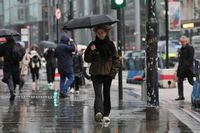The UK is grappling with a dramatic shift in weather patterns, facing severe thunderstorms and flooding just days after experiencing its warmest spring equinox in over fifty years. As temperatures soared past 20 degrees Celsius, the British populace was greeted with remarkable warmth. However, this respite was unexpectedly followed by chaos as weather alerts proliferated.
On March 20, 2025, the Met Office recorded temperatures reaching an impressive 21.3 degrees Celsius in Northolt, London, and Chertsey, Surrey. This marked the highest temperature for a spring equinox since 1972. Just days later, the landscape would dramatically change, with wildfiring storms expected to wreak havoc across much of the country.
By March 22, the UK was under significant warnings for storms as intense weather systems emerged over the South West and Midlands. Flooding forced closures on several major roads, notably sections of the M18 and parts of the M40 in Yorkshire and Warwick, respectively, as officials worked to clear water from the roadways. Emergency measures were implemented, with the Environment Agency issuing alerts across 22 areas, including Henley, Salisbury, and Hertfordshire.
The Met Office forewarned of potential localized flooding, advising travelers to exercise caution as rainfall would exceed expectations in some areas, prompting concerns over flooding. Jonathan Vautrey, a meteorologist at the Met Office, noted, "For this time in the year, it is rarer to have such intense storms. This is happening because we have had a lot of warm weather of late..." This statement captures the crux of the ongoing meteorological challenges facing the UK.
Thunderstorms brought forth additional challenges, as heavy downpours accompanied by hail and lightning struck southern England. The weekend alone witnessed around 400 lightning strikes, illustrating the storm's intensity. Areas across London and the East Midlands were especially affected, with some regions receiving up to 15mm of rain in just an hour.
In a troubling acknowledgment of changing climate patterns, Vautrey remarked, "We know that climate change is pushing our temperature extremes to new levels... We're constantly seeing warmer temperatures at earlier points of the year compared to where they normally are." This sentiment underscores the rising concern that severe weather will continue to manifest with increasing frequency due to the ongoing climate crisis.
Despite the risk of flash flooding, the warmer spring temperatures have spurred discussions about how climate change is bringing summer storms earlier in the season. Ellie Glaysyor, another meteorologist at the Met Office, elaborated on the current conditions, stating, "Heavy showers have developed across eastern parts of England this afternoon, with some hail and thunder mixed in." Such volatile shifts in climate are not just notable anomalies but indicative of a much larger pattern.
As Sunday approached, forecasts suggested a cloudy start with rain persisting in parts of the north and east. Temperature readings were anticipated to remain above average, with highs of around 15 degrees Celsius in London, 12 degrees in Birmingham, and 11 degrees in Manchester. However, frost was predicted to return to rural areas as temperatures would dip overnight, creating contrast with the recent warmth.
Jonathan Vautrey also explained how the recent warm spell aided in creating thunderstorms, stating, "That sort of heat that we’ve got around at the moment has really helped to spark off some of these thunderstorms, and a lot of moisture being drawn in with this sort of low-pressure system that’s been arriving across the UK." This insight illustrates the complex interplay of heat and atmospheric conditions necessary for storm development.
As forward-looking forecasts continue to be ambiguous, the UK appears set for a tumultuous period of weather marred by extreme patterns rooted in climate change and shifting seasonal norms. The flood alerts indicate a troubling reality moving forward, as intense summer-like storms increasingly invade the spring months.
In light of the recent weather events, citizens across the UK are left pondering the long-term implications of such rapidly changing weather. Will the UK continue to face harsh storms after uncharacteristically warm periods? Experts agree that, barring considerable improvements in addressing climate change, the fragile seasonal balance will likely tip, leaving the UK vulnerable to erratic storm conditions.








